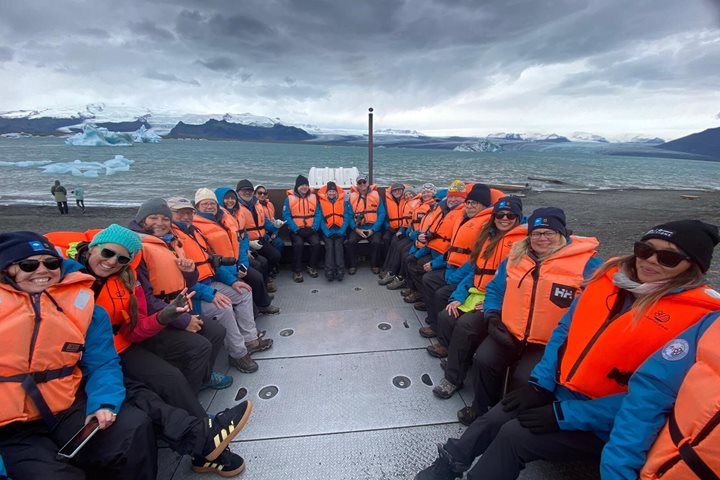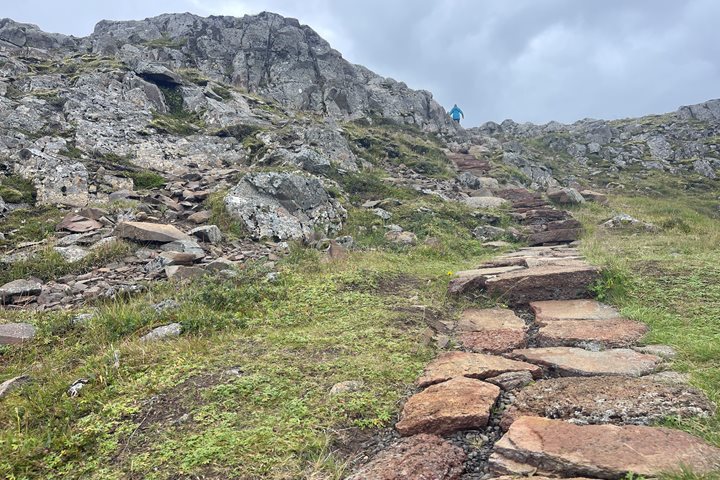We awoke early this morning just off the spectacular Latrabjarg Cliff of Iceland’s rugged northwestern region. These volcanic cliffs are composed of ancient layered tertiary basaltic outflows that provide perfect housing to millions of nesting seabirds. This site includes approximately 40% of the world population of razorbills, as well as countless thousands of guillemots (common murres to North Americans) and other members of the auk family…Atlantic puffins and black guillimots. In addition, we saw many breeding northern fulmars and kittiwakes in the waters around the cliffs. Latrabjarg, Europe's largest bird cliff, measures about 14 km (9 mi) in length and rises to 440 m (1,450 ft) in height. For centuries, brave men were roped down on the cliff face during the breeding season to collect both nesting birds and their eggs for food. Sometimes as many as 40,000 eggs and 36,000 birds were taken.
By mid-afternoon, we reached Flatey, which translates to Flat Island. Flatey is the largest of more than a thousand islands and islets in Breidafiord (Broad Bay). It is also one of the earliest Viking settlement sites in Iceland. Islands such as this were desired because one could better protect oneself against enemies and invaders. Nordic people were expert farmers and flat land was highly desired. Flatey has all the attributes that would have made it attractive to settlers: fertile soil that was easy to work, good sources of food from both land and sea, and the sea provided protection from enemy attack. As such, it was an important trading post during the Middle Ages. Vikings set off from here to reach Greenland and beyond (Baffin Island, Newfoundland, and Labrador) at the end of the first millennium. A monastery was founded here in 1172, which made Flatey the center of culture and education in Iceland at this time. The Flateyjarbok, a medieval collection of 113 pages of illuminated manuscripts written on vellum (stretched calf skin), somehow turned up here in the possession of one of the island’s farms in the 15th century. This famous book was produced in 1387 at Vididalstunga in northern Iceland. In 1659, with both the Reformation and Danish control of Iceland fully settled, the Flateyjarbok was taken from Flatey to Copenhagen. It eventually was returned to Iceland (along with some other manuscripts containing the sagas) in 1971, and they are now conserved in the Cultural Palace in Reykjarvik. Even after Flatey’s monastery was moved to Helgafell, just south of the present village Stykkisholmur on the Snaefellsnes peninsula, the cultural influence of Flatey did not diminish until the middle of the 19th century.
There is nothing left of the original monastery, but there is now a Lutheran church standing just in front of the monastic site. This attractive little wooden church was built in 1926 and has an extensive display of colorful murals on the ceiling. The artwork has an interesting story. A Catalan (Spanish) artist, Baltasar Samper, came to Iceland in the mid 1960s, became an Icelandic citizen, and at some point visited Flatey. He offered to decorate the church in exchange for free accommodation in the village. The offer was accepted and fabulous murals were completed in 1990. The art includes a Christ figure behind the altar wearing an Icelandic woolen sweater, along with extensive ceiling murals depicting the history of the Flateyjarbok to one side and scenes from island life on the other. The Biblical and historic island characters were all modeled by local people, including the image of St. Peter at Christ’s right hand, which was the artist himself.
Behind the church is a tiny restored wooden building built in 1864 that houses the oldest and smallest library in continuous use in Iceland. Inside the library is a facsimile copy of the Flateyjarbok. It should not be surprising that this 19th century building is considered to be particularly old, because there are almost no ancient buildings in Iceland. The earliest dwellings were of sod construction and driftwood. There have been no suitable lumber trees within recent centuries. Volcanic stone is unsuitable for large buildings, so there are no old great cathedrals in Iceland. Most buildings existing nowadays are of modern concrete or prefabricated design dating to the late 19th and 20th centuries.
Today, Flatey is a nature sanctuary and has just two working farms with a handful of people living on the island all year round. The community suffered a population collapse in the first half of the 20th century when there was a migration of people from this rural community to the cities in search of better paid jobs. The remaining houses have been renovated and are occupied by their owners only during the summer season. It is well-known for the breeding birds found here during the short summer months. We were able to experience firsthand many of the nesting species that utilize this island, including northern fulmars, snipe, red-necked phalaropes, ringed plovers, redshanks, purple sandpipers, oystercatchers, eiders, mallard ducks, black guillemots, Atlantic puffins, glaucous gulls, Icelandic gulls, kittiwakes, arctic terns, snow buntings, white wagtails, and probably a few others. Interestingly, Breidafiord experiences the highest tidal fluctuations in Iceland and we witnessed for ourselves today an impressive drop in the tide during our afternoon visit. It was a very fulfilling day.







